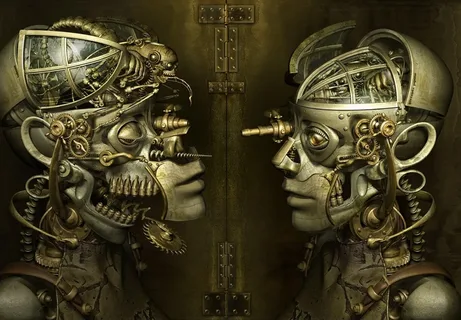Brother
Professional
- Messages
- 2,590
- Reaction score
- 528
- Points
- 113

Let's not confuse psychopaths rushing around the square with a turned on chainsaw, and sociopaths, or "strange", original people, existing as if on the verge of the norm, but still included in the social system. These concepts are almost synonymous and denote souls with the same radical, but with different spectra of feelings.Sociopath and psychopath: how are they different? How do sociopathy and psychopathy develop? Why do such people violate social norms and how do they sometimes attract us? What allows them to be not only villains, but also heroes? What sociopathic traits does the world of big business have, and what place do sociopaths have in culture and mainstream cinema? Understanding.
Psychopaths are people with an antisocial orientation. Psychopathy is a diagnosis with pronounced pathological behavior with complete preservation of thinking.
Sociopathy is a milder expression of psychopathy. If a person, with his antisociality, nevertheless fits into society, is able to exist in it, but actively neglects the rules and norms, then we are dealing with sociopathy. Its classic features include charisma, high intelligence, lack of nervousness, a tendency to lie and hypocrisy, inability to shame, repentance, empathy and love, anger, egocentrism, lack of morality and ethics.
From the point of view of psychoanalytic theory, sociopathy is a dynamic personality structure along with masochistic, hysterical and others. We all have a personality structure that is made up of genetic background and individual history. Also, sooner or later, we all face various injuries, but only a few receive a specific diagnosis.
Where does sociopathy come from? From a biological point of view, the hormonal apparatus of a sociopath produces less serotonin. Such a person is not able to "get enough" with communication, to take the necessary emotions from it, to experience empathy. To satisfy his emotional needs, he needs a completely different, stronger stimulus. In addition, such a person reacts to external stimuli more aggressively than “ordinary” people. This is his answer to any potential danger.
Sometimes childhood trauma affects the development of sociopathy: the child is faced with an early experience of violence, death, which leaves a mark on his psyche. In this case, the adrenaline received once becomes a sentence for him. As a rule, in the future, such a person has problems with trust and does not have authority.
Like the heroines of Diana Setterfield's debut novel The Thirteenth Tale, children can be sociopathic even when they are absolutely well-off. They believe they can do whatever helps them to live comfortably. At the same time, the prohibitions of adults are perceived by them as a challenge. Gradually, a psychopath can develop from such an "adrenaline" personality.
As a rule, the childhood experience of a psychopath is a hell in which there is total arbitrariness on the part of adults or the complete absence of laws, any rules and regulations. Usually they are raised by an indifferent, "absent" mother, who, in turn, may have her own history of violence, be depressed, overworked in several jobs to get food, or simply be a weak-willed victim with a tyrannical husband.
If a future sociopath grows up in a relatively prosperous environment, then he has a chance to integrate into society and find himself not only application, but also recognition. For example, he can catch criminals, like Sherlock, or solve puzzles on the brink of life and death, like Doctor House. Sherlock, while explaining to Moriarty, says: "I am the second you." And this is only partly a metaphor.

Sherlock: why are psychopaths and sociopaths attracted to us?
A sociopath can achieve really good heights on the social ladder thanks to developed intelligence, the ability to easily overcome stress and the habit of indifferently stepping over people.
What is the portrait of a socialized sociopath? Such a person experiences absolute indifference to people and social norms. At the same time, for “ordinary” people, a set of certain rules makes the world more predictable and safe, and empathy fills it with warmth and meaning. The sociopath, on the other hand, is outside the legislative field, does not need justifications, and seeks goals from outside. Nancy McWilliams, author of Psychoanalytic Diagnosis, notes that conceptually, diagnosis refers to an underlying lack of human attachment and adherence to very primitive defenses.
It is noteworthy that the sociopath is not insane and is able to take responsibility for his actions. He distinguishes good from evil and understands the laws that he deliberately violates. At the same time, when committing crimes, he does not suffer from internal conflicts, since he feels absolute permissiveness.
He juggles norms with virtuosity. A sociopath may refuse to hold generally accepted holidays, adopt traditional thinking patterns, recognize oneself as a citizen of a particular country, keep things and photographs and honor the memory of their relatives, comply with medical recommendations, comfort (he can live in a car , in a forest hut, or travel on foot) ... Such a person does not trust anyone or anything, she tests everything to the taste. Of course, on your own. There are no laws for her. She offers the world hers.
A sociopath can easily tolerate loneliness, often change partners. In the absence of empathy, the desire to create a family may arise not on a sensual, but on a pragmatic level: this is how the individual tries to better integrate into society. An example of this type in cinema is the already mentioned protagonist of the TV series "House".

Sociopath and psychopath: the differences are not that great?
Such people attract with their eccentricity and extraordinary talents, but it is almost impossible to get along with them under one roof. It is important to remember that sociopaths themselves are incapable of building deep relationships. An adult's love is built on the ability to feel and sympathize with the other. But for a sociopath, others are only a means to an end, a practically inanimate function. Exploitation is at the core of his relationship with others. Therefore, the more pronounced the sociopathic radical, the less chances there is for creating a family with such a person.
Also, a sociopathic character can be represented in a relative social norm. Then we are dealing with a person who does what others are not capable of. This means not only negative, but also positive, creative and even heroic deeds. He works in the war. He works where there is blood and death. Where it is dangerous, including in big business or in areas with great responsibility. He is in the sea, he is in space, he is under water and where the elements are raging.
This is what sociopaths are all about. Take responsibility that is difficult for an ordinary person to take. They walk on the other side of death and survive. Their knowledge is sacred. When faced with death, they experience neither suffering nor guilt. This is why they are attractive.
The psychopathic type is often reflected in literature, mythology and cinema, including the mass one. In mythology, he is the hero of the epic. The one who went down to hell and came out of it. The hero is a former warrior who is legalized by our consciousness. Our consciousness does not tolerate violence and lack of norms. If someone violates the norms and stays with us, he becomes a hero, he has a special status. At the same time, a psychopath who does not turn towards society should be punished. He is either a hero or a criminal: there is no middle ground for him. There is no warm world with a fire in the depths of the cave, where children, women and old people are.
In modern mythology, which we can easily find in Game of Thrones, the entire Lannister clan has sociopathic traits. Its representatives do not feel torment about their cruelty and enjoy absolute permissiveness: the murder of children, incest, the execution of their own son, an attack on their father - all this appears to them as the norm.
The whole family is marked to the last with a special right - the right to choose the right itself. As the heroes themselves say, "Lannisters always pay." But I want to add: "If they want it." You can only serve the Lannisters for money. In the Lannister world, no one expects loyalty or love. Everything is bought and sold there. Like no one else, they master the emotional vocabulary of manipulation.
Is it possible to live in a community with a sociopath? You can work with him. And he can be served. You can lend him a shoulder, but you should not expect the same in return. The target will always belong to him, as well as the main loot. Lions are not known to be interested in the opinion of sheep. Their main psychic protection - magical thinking - makes them, in a sense, masters.
In a global, sociological sense, the world of big business possesses sociopathic features, in which calculation, manipulation, cruelty and attempts to achieve a goal without any reflection rule. In everyday life, a sociopath acts in a similar way: not knowing how to feel, such a person chooses an action. And if he regrets anything, it is only that the next scam has failed.
And it's no surprise that the Lannister kingdom is the most comfortable of the kingdoms in Game of Thrones. These are the best lands with a pleasant climate, beautiful women and the sweetest fruits. This is the prototype of the world, which is governed by the ideology of profit. This is the dream and at the same time the fear of ordinary normal neurotics, which include the majority. The world of a sociopath is a world in which everything is possible. But at some point, he will blow up this world as well, as Baylor's sept was blown up.
A sociopath is able to look beyond the usual meanings, actions and goals for an ordinary person, to look beyond the horizon, while people continue to sit in caves, where the hearth, children, old people, pink silk curtains and standard furniture from IKEA ... The sociopath is scary and attractive at the same time, he is both the Dragon and the Hero who defeated the Dragon. There is no place for him in the middle of the norm register, he is always on the edge, at the exit or beyond “101 kilometers”.
He has no morality, and when there are no moral laws, "Their Sparrows" always appear with their sermons. As in ancient times: a shaman is a mandatory character with a leader. It is the self-proclaimed Shaman who will take the trouble to explain to the people the shadow side of the feat and speak with the voices of the gods legitimizing the new right.

